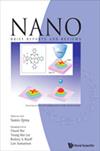Biogenic synthesis and characterization of biocompatible iron oxide nanoparticles: In vitro study of selective antiproliferative efficacy against MCF-7 cells and antibacterial potential
IF 1
4区 材料科学
Q4 MATERIALS SCIENCE, MULTIDISCIPLINARY
引用次数: 0
Abstract
The accelerating fatality rate of breast cancer patients has led to the idea of unconventional therapeutic approach in this work. Here, we report the facile, eco-benign and economically advantageous route for producing iron oxide nanoparticles employing triphala extract (TR-IONPs). MTT assay was used to assess the in-vitro anticancer effectiveness of TR-IONPs against the multi-drug-resistant breast malignant cell (MCF-7). TR-IONPs revealed a concentration-dependent effect on MCF-7 viability, with an IC[Formula: see text] value of 6.8[Formula: see text][Formula: see text]g/mL for a 24-h treatment. Thus, the cytotoxic ability was established at a much lower half-maximal inhibitory concentration. As the TR-IONPs did not show remarkable toxicity toward L929 fibroblast cells, they can be trusted as a biocompatible material for real-time biomedical applications. Apoptotic death of MCF-7 cells caused by the release of Reactive Oxygen Species (ROS) was affirmed by DCFH-DA staining, DNA fragmentation assay and cell cycle analysis. Through Kirby–Bauer Disk Diffusion assay, TR-IONPs were found to hold potent antibacterial efficacy against S. aureus, E. coli and P. aeruginosa bacterial pathogens. With the demonstrated favorable results, TR-IONPs may serve as a reliable multi-functional material in the field of nanobiotechnology.生物相容性氧化铁纳米颗粒的合成和表征:对MCF-7细胞的选择性抗增殖作用和抗菌潜力的体外研究
随着乳腺癌患者死亡率的不断上升,在这项工作中产生了非传统治疗方法的想法。在这里,我们报告了一种简单、生态和经济上有利的途径,用于生产氧化铁纳米颗粒,利用三萜提取物(TR-IONPs)。采用MTT法评估TR-IONPs对多重耐药乳腺恶性细胞(MCF-7)的体外抗癌效果。TR-IONPs对MCF-7活性的影响呈浓度依赖性,处理24小时的IC值为6.8 g/mL。因此,细胞毒能力是建立在一个低得多的一半最大抑制浓度。由于TR-IONPs对L929成纤维细胞没有明显的毒性,因此它们可以作为实时生物医学应用的生物相容性材料。DCFH-DA染色、DNA片段化和细胞周期分析证实MCF-7细胞是由活性氧(Reactive Oxygen Species, ROS)释放引起的凋亡死亡。通过Kirby-Bauer盘片扩散试验,发现tri - ionps对金黄色葡萄球菌、大肠杆菌和铜绿假单胞菌病原菌具有较强的抗菌作用。结果表明,TR-IONPs可作为纳米生物技术领域的一种可靠的多功能材料。
本文章由计算机程序翻译,如有差异,请以英文原文为准。
求助全文
约1分钟内获得全文
求助全文
来源期刊

Nano
工程技术-材料科学:综合
CiteScore
2.10
自引率
0.00%
发文量
95
审稿时长
1.6 months
期刊介绍:
NANO is an international peer-reviewed monthly journal for nanoscience and nanotechnology that presents forefront fundamental research and new emerging topics. It features timely scientific reports of new results and technical breakthroughs and also contains interesting review articles about recent hot issues.
NANO provides an ideal forum for presenting original reports of theoretical and experimental nanoscience and nanotechnology research. Research areas of interest include: nanomaterials including nano-related biomaterials, new phenomena and newly developed characterization tools, fabrication methods including by self-assembly, device applications, and numerical simulation, modeling, and theory. However, in light of the current stage development of nanoscience, manuscripts on numerical simulation, modeling, and/or theory only without experimental evidences are considered as not pertinent to the scope of NANO.
 求助内容:
求助内容: 应助结果提醒方式:
应助结果提醒方式:


